اجزای OHS پذیرش FHIR را آسان تر می کند. شما می توانید از آنها به طور جداگانه استفاده کنید یا آنها را ترکیب کنید تا پایه و اساس یک پلت فرم سلامت دیجیتال انتها به انتها را تشکیل دهید.
برنامه های اندروید مبتنی بر FHIR
با استفاده از Android FHIR SDK ، توسعهدهندگان میتوانند برنامههای Android بومی FHIR را به سرعت بسازند. SDK مجموعه ای مدولار از کتابخانه ها است که برای ارائه انعطاف پذیری برای طیف وسیعی از موارد استفاده مختلف طراحی شده است. این موارد شامل استفاده از:
- کتابخانه ضبط داده های ساخت یافته در یک برنامه موجود برای فعال کردن جمع آوری داده ها از طریق FHIR،
- کتابخانه موتور FHIR برای ساخت اولین راه حل های آفلاین بر روی FHIR و
- قابلیت های پیشرفته کتابخانه گردش کار برای فعال کردن پشتیبانی تصمیم بالینی مبتنی بر CQL از محتوای دستورالعمل های هوشمند WHO.
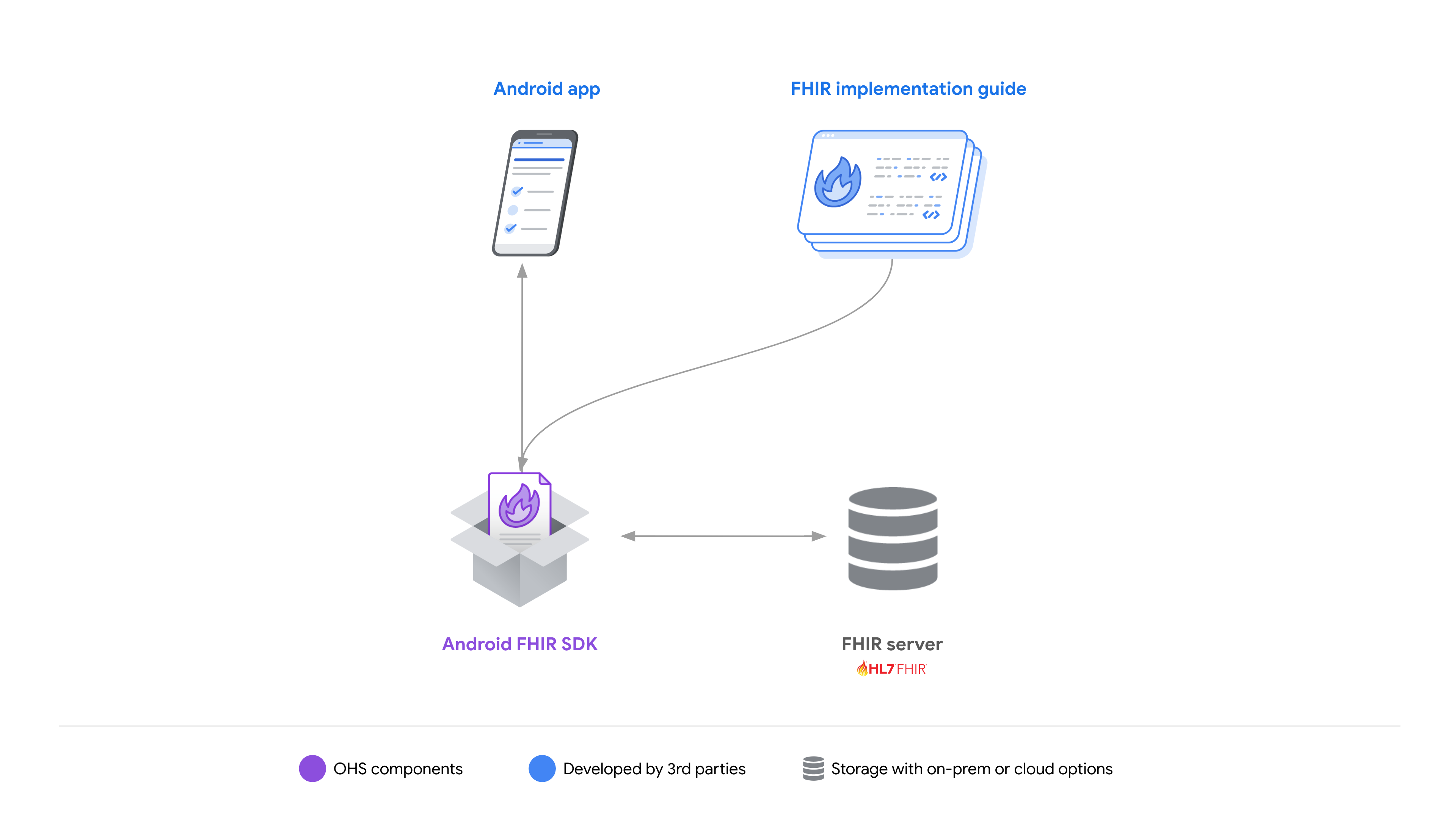
منابع :
- به سرعت با کد SDC شروع کنید.
- در مورد چگونگی ساخت راه حل های تلفن همراه توسط توسعه دهندگان با OHS بخوانید .
افزایش حریم خصوصی، استفاده از SMART-on-FHIR
FHIR Info Gateway یک پروکسی معکوس مستقل است که می توانید آن را در مقابل هر برنامه کاربردی به منظور افزایش حریم خصوصی و اجرای سیاست های کنترل دسترسی سازمانی را آسان تر کنید. هنگامی که همراه با یک برنامه مجهز به Android FHIR SDK استفاده میشود، Info Gateway همچنین میتواند عملیات همگامسازی را بهبود بخشد، به عنوان مثال، برای محدود کردن دادههای بیمار که یک کارمند بهداشتی خاص میتواند هنگام کار آفلاین بارگیری و به آن دسترسی داشته باشد.
به عنوان یک پروکسی مستقل، Info Gateway از ادغام با برنامه های SMART-on-FHIR پشتیبانی می کند.
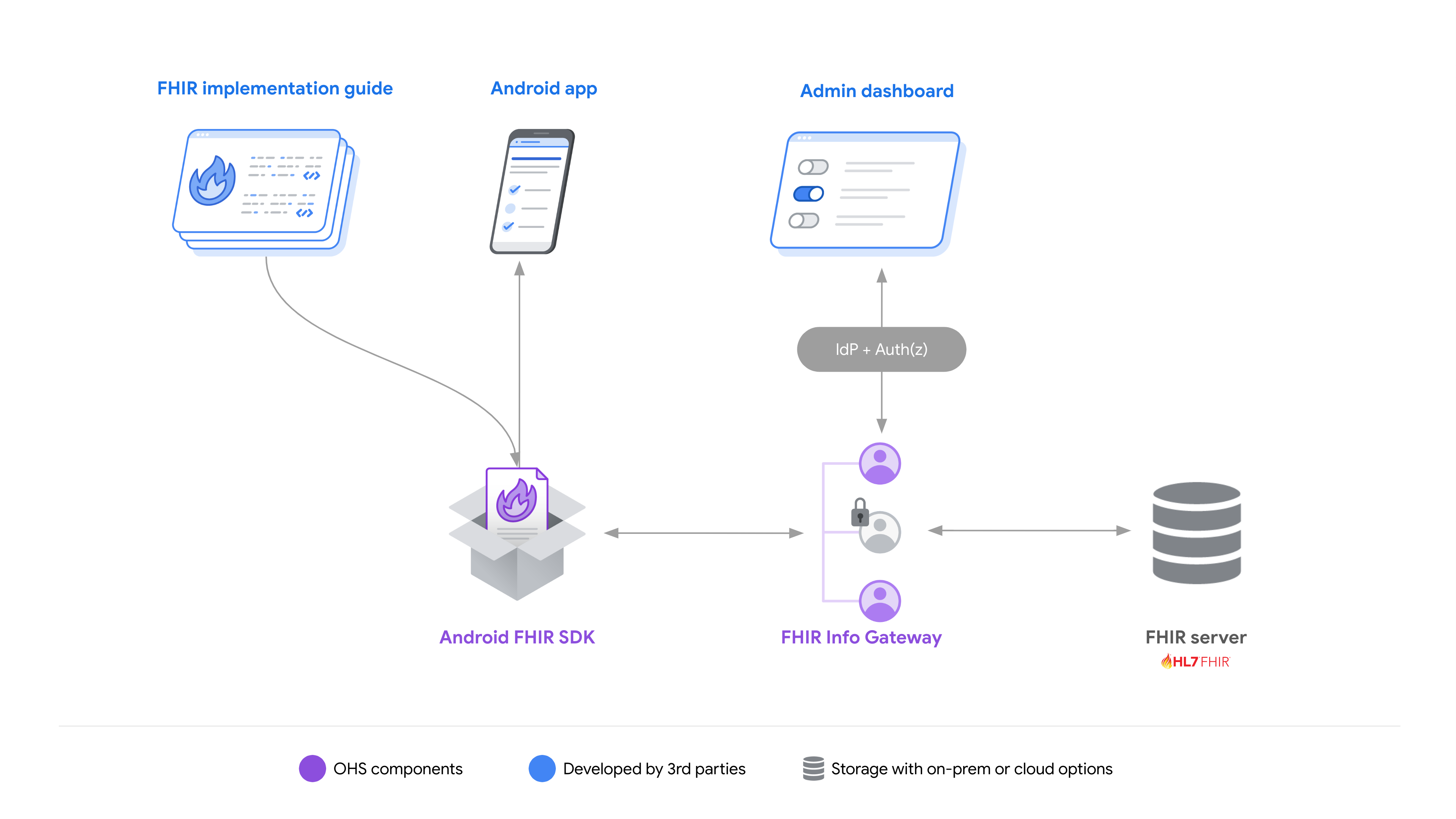
منابع :
- مخزن نمونه های برنامه FHIR را کاوش کنید تا ببینید چگونه می توان از دروازه اطلاعات FHIR با سایر اجزای OHS استفاده کرد.
راه حل های تجزیه و تحلیل FHIR
با توجه به ساختار بسیار تو در تو داده های FHIR، نوشتن پرس و جو برای ایجاد بینش می تواند چالش برانگیز باشد. لولههای داده FHIR مشکل را با یک خط لوله به راحتی قابل استقرار و مقیاسپذیر افقی که دادههای FHIR را به قالب SQL-on-FHIR تبدیل میکند، ساده میکند و امکان جستجوی دادههای FHIR از طریق SQL را فراهم میکند.
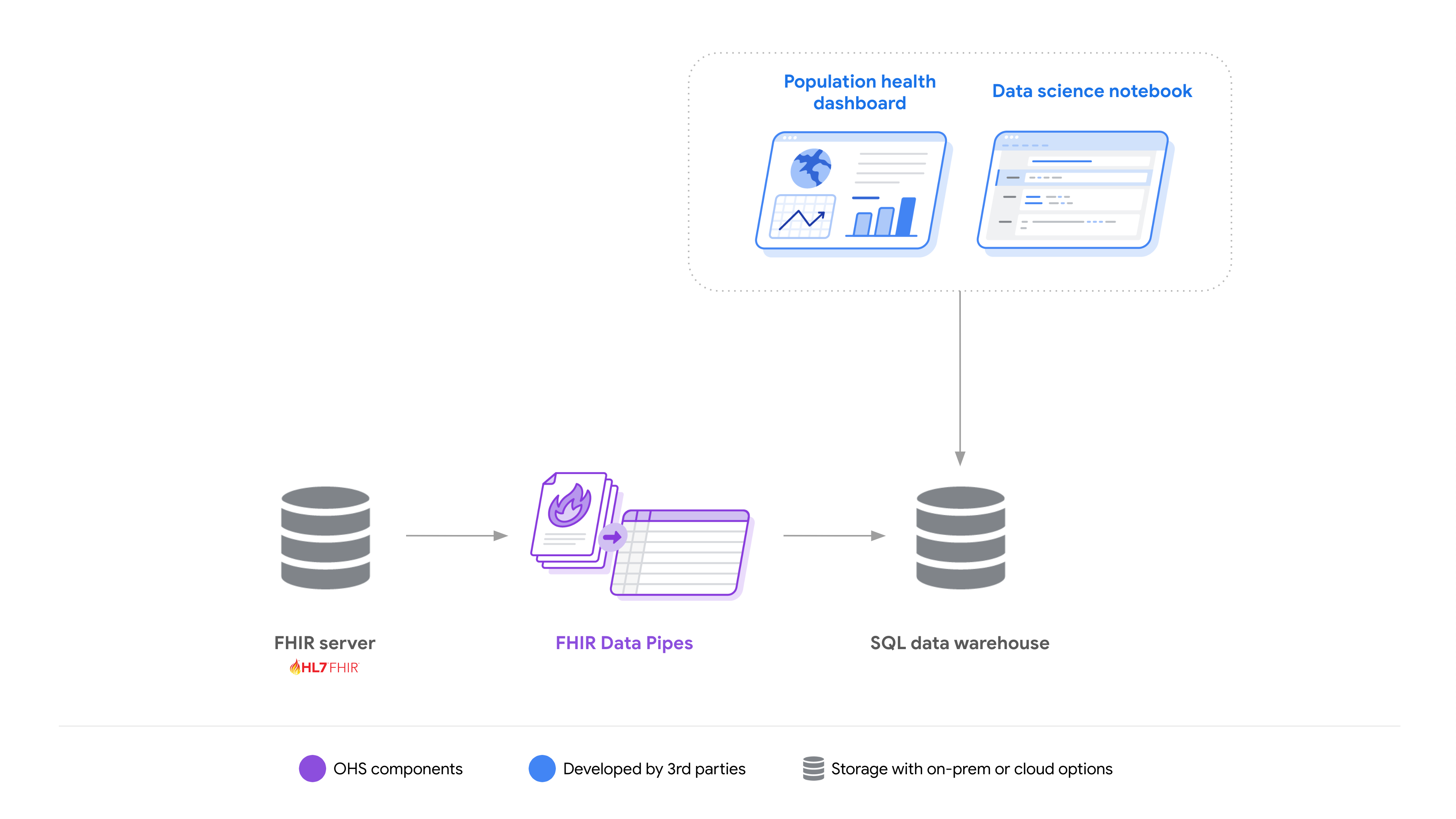
لولههای داده FHIR میتوانند در جایی که FHIR منبع دادههای مورد تجزیه و تحلیل است مفید باشد. سناریوهای رایج برای توسعه دهندگان عبارتند از:
- به عنوان توسعه یک راه حل بومی سلامت تلفن همراه FHIR - به مبانی یک راه حل سلامت دیجیتال انتها به انتها مراجعه کنید .
- به عنوان بخشی از یک راه حل تحلیلی مستقل که از FHIR استفاده می کند - نمونه معماری ترکیبی را ببینید .
منابع :
- با آموزش استقرار تک ماشین به سرعت شروع کنید.
- مخزن نمونه های برنامه FHIR را کاوش کنید تا ببینید چگونه می توان از FHIR Data Pipes با سایر اجزای OHS استفاده کرد.
مبانی یک راه حل سلامت دیجیتال انتها به انتها
استفاده از تمام اجزای OHS با هم، پایه ای را برای توسعه دهندگان ایجاد می کند تا پلتفرم ها یا راه حل های مبتنی بر FHIR بسازند. با ارائه تعدادی از ویژگی های اصلی - مانند قابلیت های همگام سازی و آفلاین - و کاهش پیچیدگی فنی کار با FHIR، توسعه دهندگان می توانند در زمان قابل توجهی صرفه جویی کنند و بر ارزش افزوده راه حل های خود تمرکز بیشتری داشته باشند.
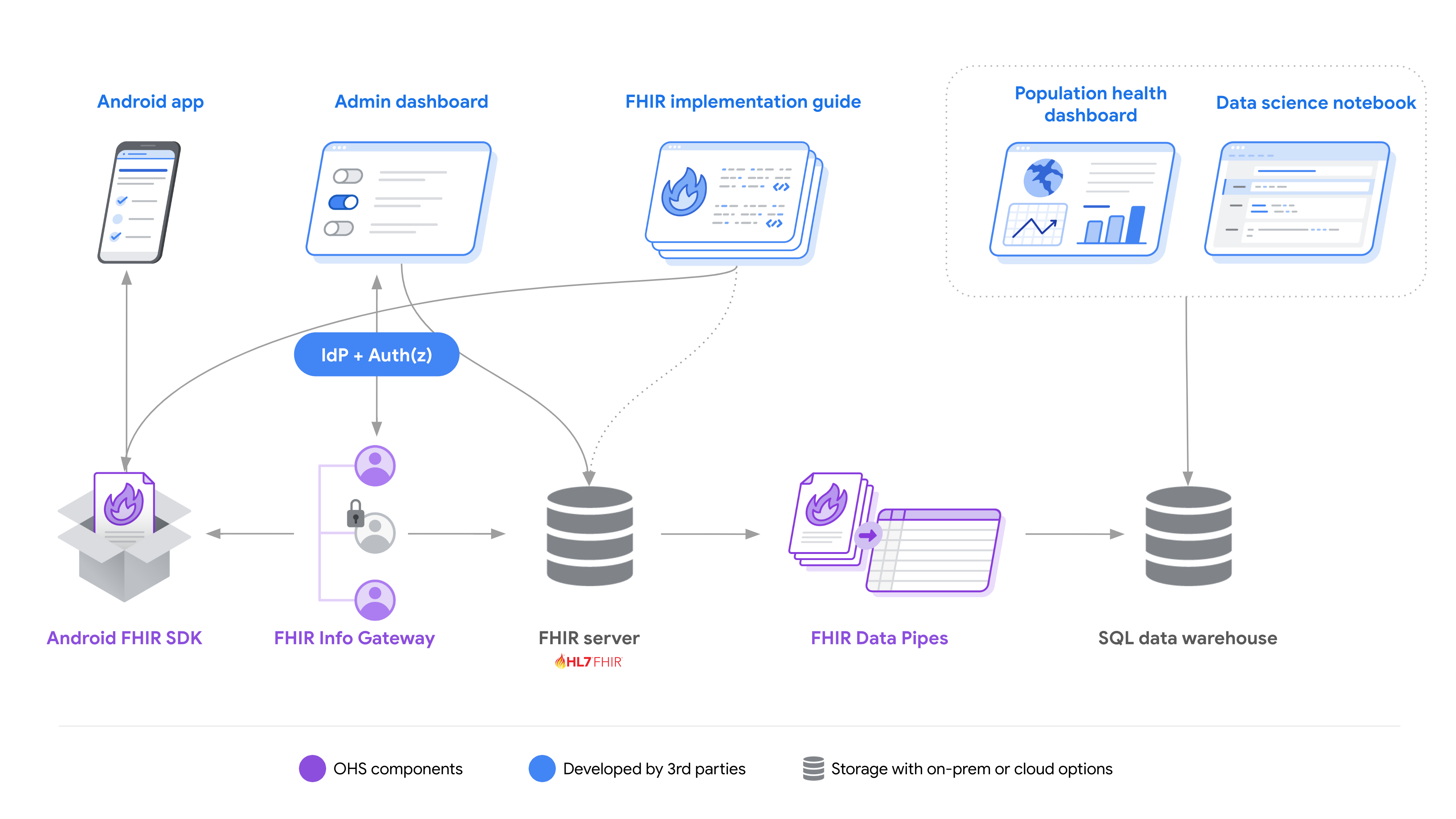
منابع :
- مخزن نمونه های برنامه FHIR را کاوش کنید تا ببینید چگونه می توان از همه مؤلفه ها با هم استفاده کرد.
- درباره نحوه استفاده Ona از OHS برای ساخت OpenSRP FHIRCore بخوانید .
نمونه معماری ترکیبی
ماژولار بودن مؤلفه OHS به توسعه دهندگان این امکان را می دهد تا قطعاتی را که به بهترین وجه به آنها در حل مشکلات خاص کمک می کند، انتخاب و انتخاب کنند.
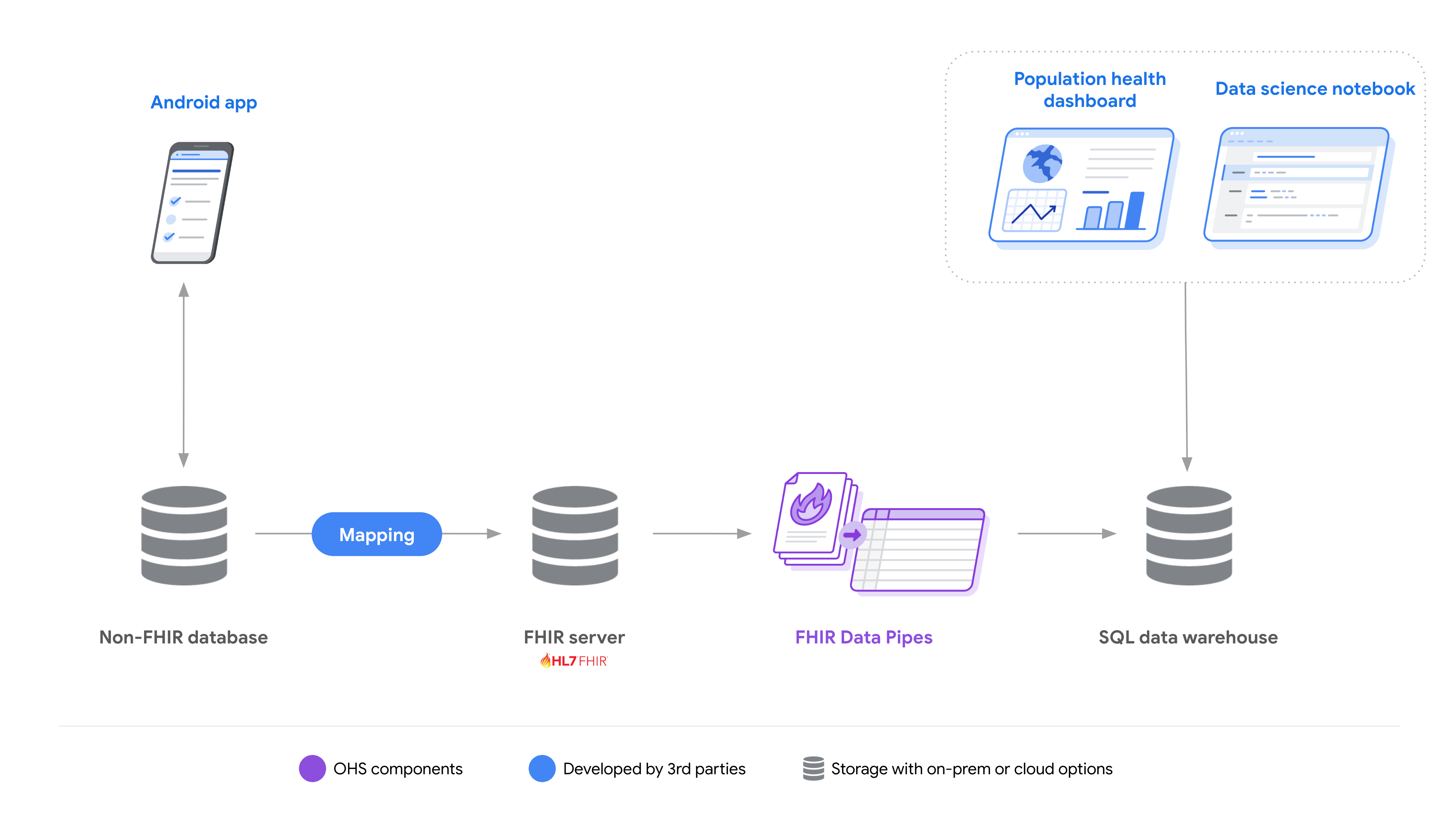
مثالهای زیادی وجود دارد که در آن انتقال بخشی از یک سیستم موجود به FHIR میتواند مفید باشد و در عین حال سایر بخشهای راهحل را همانطور که هستند حفظ کنیم. این شامل:
جمعآوری دادههای غیر FHIR به تجزیه و تحلیل مبتنی بر FHIR : در این سناریو، دادههای جمعآوریشده به روش غیر FHIR به FHIR تبدیل میشوند تا استفاده از لولههای داده OHS FHIR برای یک رویکرد مشترک برای ایجاد بینش از دادههای FHIR را امکانپذیر کند. برای تبدیل دادهها، توسعهدهندگان میتوانند از APIهای فروشنده موجود، خدمات شخص ثالث موجود مانند OpenFn مورد تأیید Global Goods یا پروژههای منبع باز مرتبط استفاده کنند.
برنامه FHIR Native برای سیستم های غیر FHIR : در این سناریو، یک برنامه تلفن همراه بومی FHIR که با استفاده از Android FHIR SDK ساخته شده است، برای ارائه مراقبت آفلاین با داده های همگام سازی شده با یک سرور FHIR استفاده می شود. از سرور FHIR، توسعه دهندگان می توانند با سیستم های موجود، آداپتورهای شخص ثالث یا کد سفارشی یکپارچه سازی کنند.
منابع :
- مخزن نمونه های برنامه FHIR را کاوش کنید تا ببینید چگونه می توان از همه مؤلفه ها با هم استفاده کرد.

